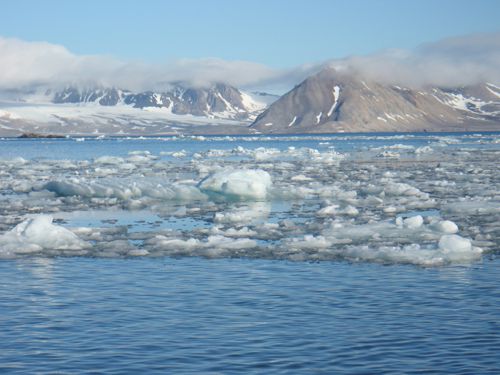The last two days have been very busy, starting with the first experiments and really testing our equipment for good.

Being in the field is always very nice, although life back home carries on as usual. The deadline for submitting papers to an international conference was today, and I finalised a paper with colleagues from Aberdeen and Liverpool on acoustic monitoring of impacts from marine renewable energies. Through several deployments in the challenging waters of Orkney, we tested devices and control areas at the European Marine Energy Centre and used different types of sonar to detect and track marine life, including seabirds (also seen on radar and confirmed by very experienced visual observers).
But what are we going to do here? Yes, we are going to listen to underwater noise from ice, and from glaciers. But why? And who cares? What are the reasons for this work, and how will it be applied later?
Noise underwater spans a large range of frequencies. The lower ones (a few tens of Hertz) can propagate for hundreds or even thousands of kilometres. They correspond to earthquakes or similar natural processes. The higher ones (up to several hundreds of kiloHertz) correspond to animal vocalisations (e.g dolphins) and man-made sonars. In the middle, there are all sorts of sources of noise: natural ones, like the weather (rain falling on the sea surface, waves crashing in the wind) or animal life (whales, fish, even shrimps), and artificial ones like sonars, industrial activities (seismic surveys, offshore building) or divers using acoustic modems. How much noise is there in the ocean already? How much can we make before becoming “noisy neighbours”?
We have answers to some of these questions, with emerging international standards and work done by different technical committees (e.g. the British Standards Institution in the UK: I am there as member of the Centre for Space, Atmospheric and Oceanic Science, University of Bath). But we do not know that much about what is happening in polar regions, because of their remoteness, and because of the very difficult conditions in which the measurements have to be made. Going to Svalbard in 2007, we showed how environmental processes and weather could be unravelled from noise from icebergs. People knew icebergs were very noisy, but not at frequencies as high as the ones we listened to (well into the ultrasound). So we decided to investigate this a bit more. We created artificial icebergs in the lab (that was fun), using different techniques. But nothing beats the real stuff: so more data was collected in the Arctic in 2009, in a fjord with lots of ice and in a fjord with no ice at all. Both sets of recordings were done in very flat seas, so we would have expected to have very little noise. In fact, the recording in the place full of ice was as noisy as if the sea state was 4 Beaufort (rather rough). So we knew the ice was really noisy, and we did some more measurements with the real stuff: tank experiments with small ice blocks carried back from Svalbard in 2012, field measurements in summer 2013 and this summer.

Understanding the sources of noise, and putting numbers on how loud ice can be, at what frequencies, will help many other people. If glacier environments are very loud already, this might help assess how certain types of human activities will impact the environment. With the noise coming from the ice, we can measure how many small ice blocks there are (they are usually small enough to be very hard to detect with ship radar when sailing in icy waters, but large enough to create damage to the ships). With the noise coming from the glaciers, we can detect when they are melting (even if no one is nearby), how they are melting, and how much fresh water they contribute to the salty oceans (too much fresh water will kill zooplankton, near the base of the local food chain).
This is why we will listen to these different types of noise, using acoustics underwater, assessing where the noise comes from, and how we can explain specific processes (e.g. the noise created by air bubbles trapped in the ice), but also how the noise from glaciers is working.
Respond